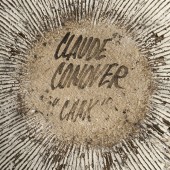![]() Printer version
Printer version
Claude Conover
1907Born Pittsburgh, Pennsylvania
1994Died
EDUCATION
—Cleveland Institute of Art, Cleveland, Ohio
PRIMARY WORK EXPERIENCE
—Commercial Designer
1960s—Studio Artist
BIOGRAPHY
Claude Conover is known for his exploration of a single form, the bottle/vase. The pieces are large scale up to 19 inches tall and characterized by short cylindrical neck and mouth approximately centered on the vessel’s shoulder. Each piece also has a plastic liner. The pieces are coil and slab- built using stoneware and are typically variations on classical forms. The monochromatic surfaces are usually left unglazed and are finished with saw blade scratched or stamped motifs or covered with linear and geometric designs created using a sgraffito technique. Often the sgraffito is so pronounced that it creates an overall textured surface. Conover also made functional wares, bowls, lamps, and animal sculptures.
Conover’s early study of sculpture and painting led to work as a commercial designer for 30 years until in the 1960s at age 55 he began to work with clay. This early design study is evident in Conover’s intricately designed surface treatment.
After retiring from commercial design, Conover devoted himself to his studio practice. He described his seven-day process to Fred Griffith for the 1983 television documentary on Claude Conover, The Bottle Maker, the artist explained his working methods in detail. “…On Mondays he rolled slabs and made vessels and their necks, letting them dry overnight. On Tuesdays he stepped back and considered what was needed to finish the forms and started putting his pots together, adding the necks and other attached pieces. On Wednesdays he finished shaping the forms, all the while “paddling and pushing,” never employing a potter’s wheel. He devoted Thursdays to scratching the pieces with a saw-tooth blade to achieve the desired surface effects. On Fridays he decided on the decorations, implementing them with his own hand-made roller to add the various patterns. He had to finish the entire process by Sunday, he explained so that he could begin again on Monday. In this way, he produced six pots every week and about 250 objects a year…”[1]
In addition to Conover’s signature, each piece has its title painted on the base. Conover is essentially a self-taught potter.
[1] De Grazia, Diane. http://clevelandartsprize.org/awardees/claude_conover.html (10/24/2018)
PUBLIC COLLECTIONS
American Museum of Ceramic Arts, AMOCA, Pomona, California
Arizona State University Art Museum, Tempe, Arizona
Butler Institute of American Art, Youngstown, Ohio
Cleveland Museum of Art, Cleveland, Ohio
Columbus Museum of Art, Columbus, Ohio
Everson Museum of Art, Syracuse, New York
Minnesota Museum of Art, Saint Paul, Minnesota
Museum of Arts and Design, New York, New York
Newark Museum, Newark, New Jersey
Philadelphia Museum of Art, Philadelphia, Pennsylvania
Scripps College, Claremont, California
Stanley Museum of Art, University of Iowa, Iowa City, Ohio
Utah Museum of Fine Arts, Salt Lake City, Utah
Western Reserve Historical Museum, Cleveland, Ohio
Wichita Art Association, Wichita, Kansas
BIBLIOGRAPHY
Cohen, Edie. “White Magic.” Interior Design 76, no. 3 (March 2005).
Hastie, Reid and Christian Schmidt. Encounter with Art. Englewood Cliffs, NJ: McGraw-Hill, 1969.
Held, Peter. Innovation and Change. Tempe, AZ: Arizona State University Art Museum, 2009.
Lewis, Janie N. “Designed by Art.” Art and Antiques 25, no. 11 (December 2002).
Nordness, Lee. Objects USA: Works by Artist-Craftsmen in Ceramic, Enamel, Glass, Metal, Plastic, Mosaic, wood, and Fiber. New York, NY: Viking Press, 1970.
Perry, Barbara. American Ceramics: The Collection of the Everson Museum of Art. New York, NY: Rizzoli International Publishers, 1989.
Trevor, Henry. Pottery Step by Step. New York, NY: Watson-Guptill, 1967.
CV or RESUME: Click Here to Download
Source: The Forrest L. Merrill Collection, Dane Cloutier Archives
Citation: Clark, Donald. "The Marks Project." Last modified August 4, 2023. http://www.themarksproject.org:443/marks/conover
















